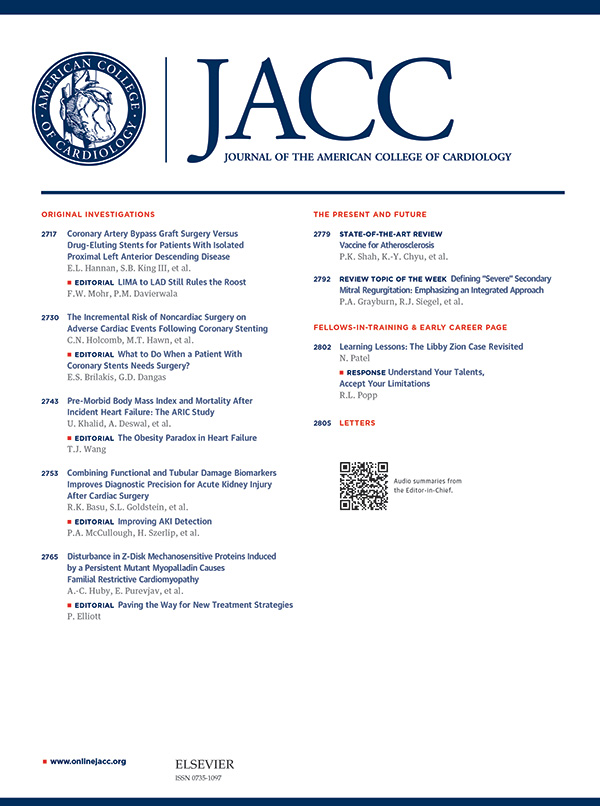Effect of Semaglutide on Cardiac Structure and Function in Patients With Obesity-Related Heart Failure
IF 21.7
1区 医学
Q1 CARDIAC & CARDIOVASCULAR SYSTEMS
引用次数: 0
Abstract
Background
Obesity is associated with adverse cardiac remodeling and is a key driver for the development and progression of heart failure (HF). Once-weekly semaglutide (2.4 mg) has been shown to improve HF-related symptoms and physical limitations, body weight, and exercise function in patients with obesity-related heart failure with preserved ejection fraction (HFpEF), but the effects of semaglutide on cardiac structure and function in this population remain unknown.
Objectives
In this echocardiography substudy of the STEP-HFpEF Program, we evaluated treatment effects of once-weekly semaglutide (2.4 mg) vs placebo on cardiac structure and function.
Methods
Echocardiography at randomization and 52 weeks was performed in 491 of 1,145 participants (43%) in the STEP-HFpEF Program (pooled STEP-HFpEF [Semaglutide Treatment Effect in People with Obesity and HFpEF] and STEP-HFpEF DM [Semaglutide Treatment Effect in People with Obesity, HFpEF, and Type 2 Diabetes] trials). The prespecified primary outcome was change in left atrial (LA) volume, with changes in other echocardiography parameters evaluated as secondary outcomes. Treatment effects of semaglutide vs placebo were assessed using analysis of covariance stratified by trial and body mass index, with adjustment for baseline parameter values.
Results
Overall, baseline clinical and echocardiographic characteristics were balanced among those receiving semaglutide (n = 253) and placebo (n = 238). Between baseline and 52 weeks, semaglutide attenuated progression of LA remodeling (estimated mean difference [EMD] in LA volume, −6.13 mL; 95% CI: −9.85 to −2.41 mL; P = 0.0013) and right ventricular (RV) enlargement (EMD in RV end-diastolic area: −1.99 cm2; 95% CI: −3.60 to −0.38 cm2; P = 0.016; EMD in RV end-systolic area: −1.41 cm2; 95% CI: −2.42 to −0.40] cm2; P = 0.0064) compared with placebo. Semaglutide additionally improved E-wave velocity (EMD: −5.63 cm/s; 95% CI: −9.42 to −1.84 cm/s; P = 0.0037), E/A (early/late mitral inflow velocity) ratio (EMD: −0.14; 95% CI: −0.24 to −0.04; P = 0.0075), and E/e′ (early mitral inflow velocity/early diastolic mitral annular velocity) average (EMD: −0.79; 95% CI: −1.60 to 0.01; P = 0.05). These associations were not modified by diabetes or atrial fibrillation status. Semaglutide did not significantly affect left ventricular dimensions, mass, or systolic function. Greater weight loss with semaglutide was associated with greater reduction in LA volume (Pinteraction = 0.033) but not with changes in E-wave velocity, E/e′ average, or RV end-diastolic area.
Conclusions
In the STEP-HFpEF Program echocardiography substudy, semaglutide appeared to improve adverse cardiac remodeling compared with placebo, further suggesting that treatment with semaglutide may be disease modifying among patients with obesity-related HFpEF. (Research Study to Investigate How Well Semaglutide Works in People Living With Heart Failure and Obesity [STEP-HFpEF]; NCT04788511; Research Study to Look at How Well Semaglutide Works in People Living With Heart Failure, Obesity and Type 2 Diabetes [STEP-HFpEF DM]; NCT04916470)
塞马鲁肽对肥胖所致心力衰竭患者心脏结构和功能的影响
背景:肥胖与不良心脏重塑有关,是心力衰竭(HF)发生和发展的关键因素。每周一次的塞马鲁肽(2.4 毫克)已被证明可改善肥胖相关性射血分数保留型心力衰竭(HFpEF)患者的 HF 相关症状和身体限制、体重和运动功能,但塞马鲁肽对该人群心脏结构和功能的影响仍不清楚:在这项 STEP-HFpEF 计划的超声心动图子研究中,我们评估了每周一次的塞马鲁肽(2.4 毫克)与安慰剂对心脏结构和功能的治疗效果:在 STEP-HFpEF 计划(合并 STEP-HFpEF [塞马鲁肽对肥胖和 HFpEF 患者的治疗效果] 和 STEP-HFpEF DM [塞马鲁肽对肥胖、HFpEF 和 2 型糖尿病患者的治疗效果] 试验)的 1,145 名参与者中,有 491 人(43%)在随机化和 52 周时接受了超声心动图检查。预设的主要结果是左心房(LA)容积的变化,其他超声心动图参数的变化作为次要结果进行评估。采用按试验和体重指数分层的协方差分析法评估了塞马鲁肽与安慰剂的治疗效果,并对基线参数值进行了调整:总体而言,接受塞马鲁肽治疗的患者(253人)和接受安慰剂治疗的患者(238人)的基线临床和超声心动图特征是平衡的。从基线到52周期间,塞马鲁肽减轻了LA重塑的进展(LA容积的估计平均差[EMD]为-6.13 mL; 95% CI: -9.85 to -2.41 mL; P = 0.0013)和右心室(RV)扩大(RV舒张末期面积的估计平均差[EMD]为-1.99 cm2; 95% CI: -9.85 to -2.41 mL; P = 0.0013):-1.99平方厘米;95% CI:-3.60至-0.38平方厘米;P = 0.016;右心室收缩末期面积的EMD:-1.41平方厘米;95% CI:-2.42至-0.40] 平方厘米;P = 0.0064)。塞马鲁肽还改善了E波速度(EMD:-5.63 cm/s;95% CI:-9.42 至 -1.84 cm/s;P = 0.0037)、E/A(二尖瓣早期/晚期血流速度)比值(EMD:-0.14;95% CI:-0.24 至 -0.04;P = 0.0075),以及 E/e'(二尖瓣早期血流速度/二尖瓣舒张早期瓣环速度)平均值(EMD:-0.79;95% CI:-1.60 至 0.01;P = 0.05)。糖尿病或心房颤动状态不会改变这些关联。塞马鲁肽对左心室的尺寸、质量或收缩功能没有明显影响。使用塞马鲁肽后,体重减轻幅度越大,左心室容积缩小幅度越大(Pinteraction = 0.033),但与E波速度、E/e'平均值或左心室舒张末期面积的变化无关:结论:在 STEP-HFpEF 计划超声心动图子研究中,与安慰剂相比,塞马鲁肽似乎能改善心脏重塑的不良影响,这进一步表明塞马鲁肽治疗可能对肥胖相关高频心衰患者的疾病有改善作用。(调查塞马鲁肽在心力衰竭和肥胖患者中的疗效的研究[STEP-HFpEF];NCT04788511;调查塞马鲁肽在心力衰竭、肥胖和2型糖尿病患者中的疗效的研究[STEP-HFpEF DM];NCT04916470)。
本文章由计算机程序翻译,如有差异,请以英文原文为准。
求助全文
约1分钟内获得全文
求助全文
来源期刊
CiteScore
42.70
自引率
3.30%
发文量
5097
审稿时长
2-4 weeks
期刊介绍:
The Journal of the American College of Cardiology (JACC) publishes peer-reviewed articles highlighting all aspects of cardiovascular disease, including original clinical studies, experimental investigations with clear clinical relevance, state-of-the-art papers and viewpoints.
Content Profile:
-Original Investigations
-JACC State-of-the-Art Reviews
-JACC Review Topics of the Week
-Guidelines & Clinical Documents
-JACC Guideline Comparisons
-JACC Scientific Expert Panels
-Cardiovascular Medicine & Society
-Editorial Comments (accompanying every Original Investigation)
-Research Letters
-Fellows-in-Training/Early Career Professional Pages
-Editor’s Pages from the Editor-in-Chief or other invited thought leaders

 求助内容:
求助内容: 应助结果提醒方式:
应助结果提醒方式:


